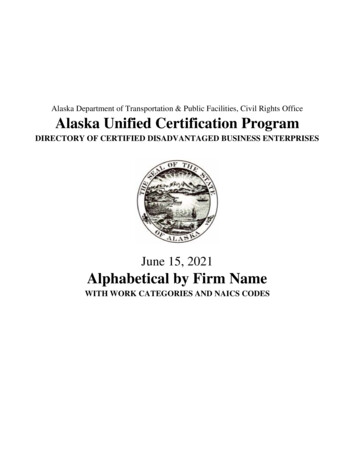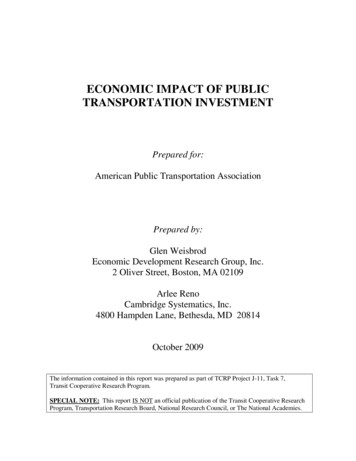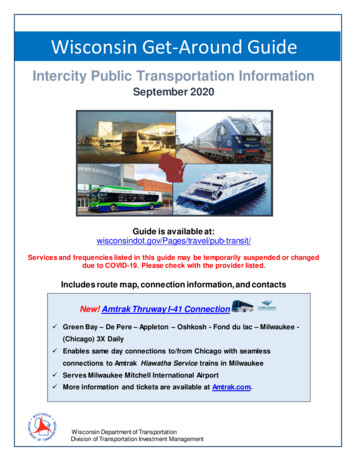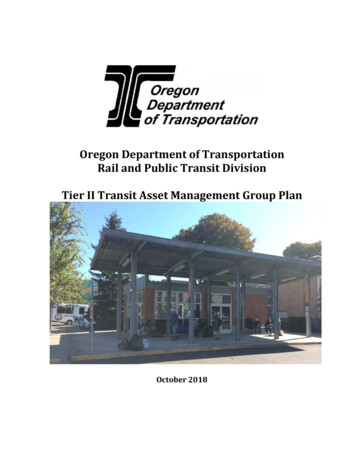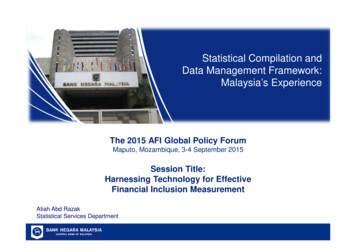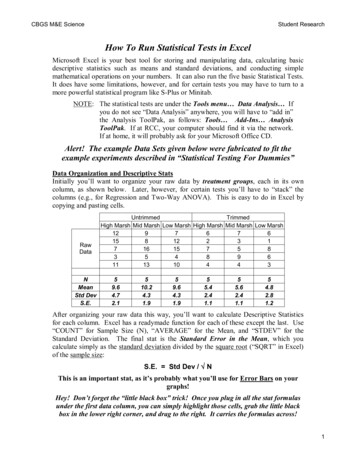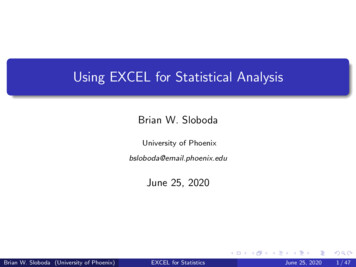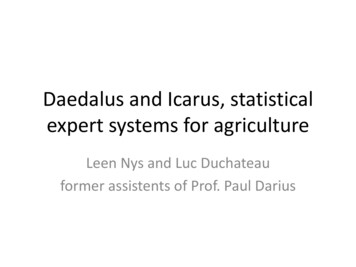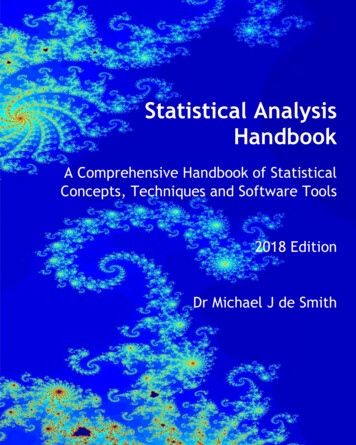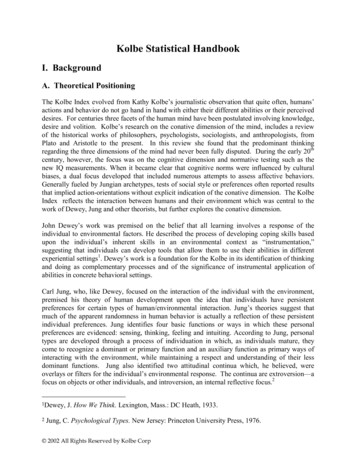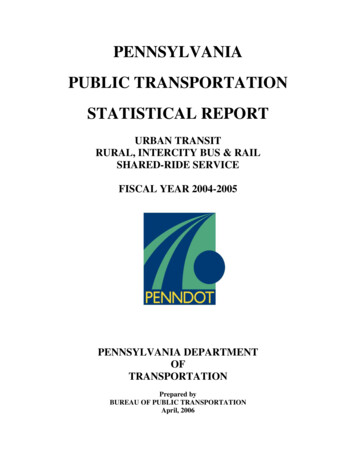
Transcription
PENNSYLVANIAPUBLIC TRANSPORTATIONSTATISTICAL REPORTURBAN TRANSITRURAL, INTERCITY BUS & RAILSHARED-RIDE SERVICEFISCAL YEAR 2004-2005PENNSYLVANIA DEPARTMENTOFTRANSPORTATIONPrepared byBUREAU OF PUBLIC TRANSPORTATIONApril, 2006
PENNSYLVANIAURBAN TRANSITSTATISTICAL REPORTFISCAL YEAR 2004-2005PENNSYLVANIA DEPARTMENTOFTRANSPORTATIONPrepared byBUREAU OF PUBLIC TRANSPORTATIONApril, 2006
The preparation of this report was financed in part by a grant from the Federal TransitAdministration of the U.S. Department of Transportation.The opinions, findings, and conclusions expressed in this report are those of theauthors, who are responsible for the facts and accuracy of the material presented herein.The contents do not necessarily reflect the official views or policy of the Federal TransitAdministration.
For more information, visit us at the official PENNDOT website at www.dot.state.pa.us.BUREAU OF PUBLIC TRANSPORTATION (BPT) VISIONSafe, convenient, affordable public transportation is available for all citizens throughout theCommonwealthBPT MISSIONAdminister high quality public transportation programs offering financial and technicalassistance to local transportation providersBPT GOALSDEMONSTRATE LEADERSHIP IN SUPPORTING THE DEVELOPMENT ANDENHANCEMENT OF PUBLIC TRANSPORTATION BY: documenting and promoting the benefits for both users and non-users (mobility, quality oflife, environmental, etc.);advocating for responsible funding levels to support development and enhancement ofpublic transportation facilities and services;anticipating and adapting to changes in the transportation marketplace through strategicplanning;supporting the innovation and development of advanced technologies and techniques forimproving public transportation;developing and strengthening partnerships in support of public transportation programsand services;creating a culture for continuous organization improvement; and striving for recognitionas a "leader in the field" of public transportation administration
TABLE OF CONTENTSA - GLOSSARY OF TERMS . .iiiB - NARRATIVEI.II.III.IV.INTRODUCTION . . .FINANCIAL DATA . .NON-FINANCIAL DATA . . .PERFORMANCE INDICATORS . . .143144C - .19.20.21.22.23.24.25.26.27.28.29.30.URBAN TRANSIT SYSTEMS AND SERVICE AREAS .SELECTED URBAN TRANSIT OPERATING STATISTICS .STATE URBAN TRANSIT ASSISTANCE .REVENUE, EXPENSE & DEFICIT STATISTICS (SYSTEM TOTAL).REVENUE, EXPENSE & DEFICIT STATISTICS (FIXED ROUTE) .REVENUE, EXPENSE & DEFICIT STATISTICS (PARATRANSIT).REVENUE, EXPENSE & DEFICIT STATISTICS – ANNUALPERCENT CHANGE (SYSTEM TOTAL) .REVENUE, EXPENSE & DEFICIT STATISTICS – ANNUALPERCENT CHANGE (FIXED ROUTE) . REVENUE, EXPENSE & DEFICIT STATISTICS – ANNUALPERCENT CHANGE (PARATRANSIT) .GOVERNMENT OPERATING GRANTS .GOVERNMENT OPERATING GRANTS – ANNUAL PERCENTCHANGE PTAF APPROVALS . PTAF EXPENDITURES . .ACT 3 APPROVALS .ACT 3 EXPENDITURES . .ADDITIONAL FEDERAL AND STATE CAPITAL FUNDSPROVIDED . .CAPITAL ASSISTANCE FOR OPERATING EXPENSES (CAOE).FREE TRANSIT PROGRAM FOR SENIOR CITIZENS GRANTS SHARED RIDE PROGRAM FOR SENIOR CITIZENS GRANTS .FARE STATISTICS (FIXED ROUTE) . .TOTAL PASSENGER TRIP STATISTICS . .ORIGINATING PASSENGER STATISTICS . .SENIOR CITIZEN REDERSHIP STATISTICS . .PASSENGER MILE STATISTICS . .TOTAL VEHICLE HOUR STATISTICS . .TOTAL VEHICLE MILE STATISTICS . . .ENERGY STATISTICS (FIXED ROUTE) EMPLOYEE STATISTICS TOTAL VEHICLE STATISTICS .ADDITIONAL VEHICLE STATISTICS (FIXED ROUTE) . 940414243
31. REVENUE, EXPENSE & DEFICIT PER ORIGINATING PASSENGER(FIXED ROUTE) 32. REVENUE, EXPENSE, & DEFICIT PER PASSENGER MILE(FIXED ROUTE) 33. REVENUE, EXPENSE, & DEFICIT PER TOTAL VEHICLE HOUR(FIXED ROUTE) 34. REVENUE, EXPENSE & DEFICIT PER TOTAL VEHICLE MILE(FIXED ROUTE) 35. ORIGINATING PASSENGERS PER TOTAL VEHICLE HOUR .36. ORIGINATING PASSENGERS PER TOTAL VEHICLE MILE . 37. PASSENGER MILES PER TOTAL VEHICLE HOUR 38. PASSENGER MILES PER TOTAL VEHICLE MILE .4546474849505152D - FIGURES1. DISTRIBUTION OF REVENUE AND EXPENSES . 182. OPERATING INCOME AND GRANTS 213. PASSENGER DISTIBUTION . 36II
GLOSSARY OF TERMSAverage Fare: Farebox revenuedivided by originating farepayingpassengers.Revenue/Expense Ratio: Determinedby dividing total operating revenue bytotal operating expense and multiplyingby 100. This differs from the Act 26 of1991 (Pennsylvania PublicTransportation Law) definition. The Act26 operating ratio differs in that itincludes PTAF asset maintenance fundsas part of operating revenue andexcludes depreciation of capital assetsfrom operating expenses.Average Trip Length: The averagedistance traveled by passengers on thesystem expressed in miles, to onedecimal place.Operating Deficit: Total operatingexpense minus total operating revenue.Total Vehicle Miles/Hours: Themiles/hours a vehicle travels while inrevenue service plus deadheadmiles/hours.Operating Expense: The total expensesincurred by a transit agency through itstransit operations. These include wagesand salaries, fringe benefits, tires,materials and supplies, fuel and utilitycosts, insurance, purchased services, andother operating expenses.Senior Citizen Passengers: All persons65 years of age or older, carried undertheState's Free Transit Program, (who arenot required to pay fares during off-peakperiods) or Shared Ride Program forSenior Citizens.Operating Revenue: The total revenueearned by a transit agency through itstransit operations. It includes passengerfares, senior citizen grants, charterrevenue, school contract revenue,advertising and other revenue.Spare Ratio: The number of transitvehicles in excess of those needed tomeet peak scheduled requirements as apercentage of total vehicles.Originating Passengers: Transit ridesby initial board patrons only (includessenior citizens but excludes transfers).Total Passengers: The total of alloriginating passengers plus transferpassengers on second and successiverides.Passenger Miles: The total number ofmiles traveled by all passengers usingthe system, calculated by multiplyingtotal passengers by average trip length.Unit of Energy: Unit of energy isexpressed in equivalent gallons of dieselfuel. Electric conversion to gallons ofdiesel fuel is calculated using aconversion factor of 10 kwh/gal.Peak Scheduled Vehicles: Themaximum number of vehicles requiredto operate the scheduled service from 7a.m. to 8 a.m. or 4:30 p.m. to 5:30 p.m.on a weekday.Urbanized Area: As defined in the 2000Census of Population, an incorporatedplace and adjacent densely settledsurrounding area that together have aminimum population of 50,000 or moreinhabitants.Population of Service Area (2000Census): The urbanized area populationresiding within each municipality servedby regularly scheduled mass transitservice routes.III
I – INTRODUCTIONThe 2004-05 Pennsylvania UrbanTransit Statistical Report is a summary ofselected financial and operating data forthe state assisted public transportationcarriers in the urbanized areas ofPennsylvania. This report, which hasbeen published on an annual basis since1973-74, is based on informationcollected through the Department ofTransportation's state operating andcapital assistance financial grant reports.The state fiscal year runs from July 1through June 30.In order to allow better comparisonsbetween transit systems, data is presentedon several tables as total transit systemdata and also broken down into fixedroute and paratransit categories.However, it is cautioned that each systemoperates under a unique set ofcircumstances that are determined, inpart, by the demographics, financialstatus and goals and objectives of localcommunities. Therefore, directcomparisons between systems may notalways be appropriate.Data contained in this report providestatistical information for the urban areamass transit systems in Pennsylvania.Table 1 provides each system's fullname, service area, and service areapopulation. Table 2 provides statewideurban transit information for keyfinancial and non-financial elements.Transit systems included in this reporthave been grouped into the followingcategories based on the number ofvehicles they operate: Class 1 systems(over 1,000 vehicles), Class 2 systems(300-999 vehicles), and Class 3 systems(under 300 vehicles). Currently, theSoutheastern PennsylvaniaTransportation Authority (SEPTA) is theonly Class 1 system and the PortAuthority of Allegheny County (PAAC)the only Class 2 system in Pennsylvania.The other smaller urban transit systems inthe Commonwealth are Class 3 systems.Several items of data presented inearlier reports may not correspond to datapresented in this report for the sameperiod. Changes in accountingprocedures and in the definition or thecategorization of certain data are amongthe reasons that the statistics for sometransit systems may seem not tocorrespond from year to year. Generally,most of these changes are relativelyminor.Although the PennsylvaniaDepartment of Transportation hascollected, compiled and edited thisinformation, the ultimate responsibilityfor its accuracy rests with the transitagencies which submit annual grantapplications and final grant reports.Additional information concerningtransit assistance programs administeredby the Department can be obtained from:Pennsylvania Department of TransportationBureau of Public TransportationP. O. Box 3151Harrisburg, Pennsylvania 17105-3151Karen J. Rae, Deputy Secretary for Local and Area Transportation1
TABLE 1LIST OF URBAN TRANSIT SYSTEMS AND SERVICE AREASAGENCYCLASS 1SEPTA-CTDSEPTA-VDSEPTA-FDSEPTA-RRDSERVICE AREAPOPULATION(2000 Census)AGENCY NAMESERVICE AREACity Transit DivisionVictory DivisionFrontier DivisionRegional Rail DivisionPhiladelphiaChester/Delaware Co.Bucks/Montgomery Co.Bucks/Chester/Delawre/Montgomery/Phila. Co.CLASS 1 SUBTOTAL3,728,909CLASS 2PAACPort Authority ofAllegheny CountyCLASS 2 SUBTOTALCLASS 3AMTRANAltoona Metro TransitBARTABerks Area ReadingTransportation AuthorityBCTABeaver CountyTransit AuthorityCAPITOL BUS Capitol Bus CompanyCATCapital Area TransitCATACentre AreaTransportation AuthorityCCTACambria CountyTransit AuthorityCOLTCounty of LebanonTransit AuthorityCOLTSCounty of LackawannaTransit SystemEMTAErie MetropolitanTransit AuthorityFACTFayette Area CoordinatedTransportationHPTHazleton Public TransitLANTALehigh and NorthamptonTransportation AuthorityLCTALuzerne CountyTransportation AuthorityMMVTAMid Mon ValleyTransit AuthorityPOTTSTOWN Pottstown Urban TransitRRTARed Rose TransitAuthoritySVSSShenango Valley ShuttleServiceWASHINGTON City of WashingtonWBTWilliamsport Bureau ofTransportationWCTAWestmoreland CountyTransit AuthorityYCTAYork CountyTransportation AuthorityCLASS 3 SUBTOTALAllegheny County1,753,136AltoonaReading69,608240,264Beaver County204,441HarrisburgHarrisburgState 0,327Scranton209,243Erie194,804Fayette TOTAL9,247,6982
TABLE 22004-05 SELECTEDURBAN TRANSIT OPERATING STATISTICS(Comparisons with 2003-04)FINANCIALAmountTotal Operating RevenueTotal Operating ExpenseTotal Operating DeficitRevenue/Expense RatioAverage Base Fare (Fixed Route)Revenue per Originating PassengerExpense per Originating PassengerDeficit per Originating PassengerRevenue per Vehicle MileExpense per Vehicle MileDeficit per Vehicle Mile 572,366,544 1,340,440,713 768,074,16942.7% 2.00 1.81 4.23 2.43 3.24 7.59 4.35OPERATING ASSISTANCETotal Operating AssistanceFederal Operating AssistanceState Operating AssistanceLocal Operating %2.1%7.2%7.7%Amount 400,388,126 15,254,993 286,218,800 98,914,333Change6.7%13.0%6.6%6.2% 1.265.9%RIDERSHIPOriginating PassengersSenior Citizen PassengersOriginating Passengers per Vehicle HourOriginating Passengers per Vehicle .0%1.5%1.1%SERVICEVehicle HoursVehicle MilesTotal VehiclesTotal Vehicles (Fixed Route)Peak Vehicles (Fixed Route)Spare Ratio (Fixed Route)Total EmployeesVehicle Miles per EmployeeAverage Vehicle Age (Fixed 29.3%-1.1%0.8%3.7%Operating Assistance per Originating Passenger3
II – FINANCIAL DATArevenue, senior citizen grants, and otherrevenue. Farebox revenue includes allfares (see Table 20 for fare statistics),whether they are full fares or reducedfares, along with zone charges, transferfees, express surcharges,daily/weekly/monthly pass income, tokensales and any other fees paid by riders ona per ride basis. Pennsylvania's SeniorCitizen Grants help reimburse transitsystems for revenue losses they incur bypermitting senior citizens to use fixedroutes service free during off-peak hoursand paratransit service at a reduced fare.Other revenue includes contract revenuereceived on other than a per ride basis aswell as charter and other miscellaneousrevenue. Excluded from operatingrevenue are all government assistanceprovided to cover operating losses.During fiscal year 2004-05, 768.1million in state assistance was providedto urban transit systems. TheCommonwealth funding included 286.2million in operating assistance and anadditional 108.5 million in SeniorCitizen Grant funding. An additional 166.0 million in PTAF dedicated funds, 69.7 million in Act 3 dedicated funding,and 137.7 million in capital bondpayments were also provided. Table 3provides the amount of state assistancereceived by each transit system.REVENUES AND EXPENSESKey financial information on eachurban transit system's operating revenue,expenses, revenue/expense ratio, anddeficit are presented for fiscal year 200405 on tables 4 through 6. Tables 7through 9 indicate the annual percentchange for operating revenue, expensesand deficit.Operating expenses include all costsassociated with the day to day operatingof the system. This category may notinclude depreciation of capital assets asthese are usually acquired with separatestate and federal capital grants.The basic indicator of a transitagency's financial performance is therevenue/expense ratio.* This ratiomeasures the degree to which a transitagency is able to cover its operating costby its operating revenue. InPennsylvania, the statewiderevenue/expense ratio during 2004-05was 42.7 percent.On a statewide basis, total operatingrevenue increased 1.7 percent duringfiscal year 2004-05, while total operatingexpenses increased 6.8 percent. Thisresulted in a 10.9 percent increase intransit deficits for this reporting period.Deficit per originating passenger (fixedroute) increased 10.6 percent during theyear.Total operating revenue consists ofthree major components: farebox*Note that the revenue/expense ratio referred to here differs from the Act 26 definition ofoperating ratio. The Act 26 operating ratio differs in that it includes PTAF asset maintenance fundsas part of operating revenue and excludes depreciation of capital assets from operating expenses.4
GOVERNMENT OPERATING ASSISTANCEeach system’s adjusted base grantpercentage of total Class 3adjusted base grants.Table 10 and Table 11 show theamount and annual percent change forgovernment operating assistance grantsreceived by each urban area transitsystem. State base operating assistanceis an annual general fund appropriationwhich began in FY 1970-71. Thedistribution of state base operatingassistance is dictated by theCommonwealth’s Public TransportationLaw. Based upon this distributionformula SEPTA receives 70% andPAAC receives 25.3% of availablefunding. The remaining 4.7% isdistributed to each Class 3 urban transitsystem based on the following factors:(b) 25% of such excess is distributedto Class 3 systems based uponeach system’s latest vehicle milepercentage of total Class 3vehicle miles.(c) 25% of such excess is distributedto Class 3 systems based uponeach system’s latest operatingrevenue percentage of total Class3 operating revenue.Fiscal year 2004-05 was theeighth year of a special supplementaloperating appropriation to support theenhancement of public transportationservices in small urban and rural areas.This 1 million special appropriationwas divided among Class 3 UrbanSystems ( 643,115), Class 4 RuralSystems ( 106,885), and a Welfare toWork demonstration program( 250,000).(1) Each Class 3 system receives 100%of its FY1990-91 adjusted baseoperating assistance grant.(2) With respect to any portionremaining after each Class 3 systemreceives the amount just described,the following applies:(a) 50% of such excess is distributedto Class 3 systems based upon5
PTAF INFORMATION(3) the system's percentage of totalvehicle miles for all Class 3systems in the preceding yearIn August 1991 the GeneralAssembly enacted Act 26 whichestablished for the first time inPennsylvania a dedicated fund for statetransit assistance.This fund, thePennsylvania Transportation AssistanceFund (PTAF), is annually financed usingthe proceeds of the following fiveearmarked taxes and fees:(4) the system's percentage of totalvehicle hours for all Class 3systems in the preceding year(5) the system's percentage of totalpassengers for all Class 3systems in the preceding year(1) 1 fee per tire on the sale of tires(2) 2 per day fee on motor vehiclerentalsThe first two factors are weighed25% each and the remaining threefactors are weighed 16 2/3% each indetermining each year's Class 3 PTAFgrant allocations. Since most of thesevariables change each year, thepercentage of the total available PTAFfunds that each Class 3 system receivesvaries each year.(3) 3% tax on the lease of motorvehicles(4) .937% transfer of sales taxproceeds (Replaces original taxon periodical, large truck leases,and the PURTA tax.)Urban systems may use the PTAFfunds that they annually receive from theDepartment for either asset maintenanceor capital assistance, or they may deferuse of these funds until a future yearsince PTAF funds do not lapse. PTAFfunds used for asset maintenance canonly be used to fund selected operatingexpenses related to (1) vehiclemaintenance, (2) non-vehiclemaintenance and (3) materials andsupplies.Each month the proceeds collectedduring the prior month are distributed bythe Department to each urban transitsystem based on an Act 26 allocationformula. Table 12 provides the PTAFpayments received by each systemduring FY 2004-05. Based on thisformula SEPTA receives 70.3% ofavailable PTAF funding, Port Authorityreceives 25.4% and the remainder isdistributed to each Class 3 urban transitsystem based the following five financialand operating factors:Each fiscal year urban systemssubmit a proposed PTAF budget to theDepartment identifying their intendeduse of PTAF funds. In addition, systemsmust submit a single or consolidatedgrant application for each capital projectand/or asset maintenance project forwhich they desire to use PTAF funds.Systems may not use PTAF funds forany proposed project until their(1) the system's percentage of totalClass 3 urban funding in FY1990-91 for maintenance ofeffort purposes(2) the system's percentage of thetotal Class 3 federal "cap" onSection 9 operating assistance6
PTAF funds exceed 200 million atwhich time the original Act 26 limitswill become e
MMVTA Mid Mon Valley Monessen 56,508 Transit Authority POTTSTOWN Pottstown Urban Transit Pottstown 51,000 RRTA Red Rose Transit Lancaster 420,920 Authority SVSS Shenango Valley Shuttle Sharon 43,783 Service WASHINGTON City of Washington Washington 61,634 WBT
